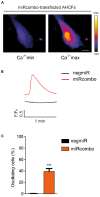MicroRNA-Mediated Direct Reprogramming of Human Adult Fibroblasts Toward Cardiac Phenotype
- PMID: 32582662
- PMCID: PMC7297084
- DOI: 10.3389/fbioe.2020.00529
MicroRNA-Mediated Direct Reprogramming of Human Adult Fibroblasts Toward Cardiac Phenotype
Abstract
Modulation of microRNA expression holds the promise to achieve direct reprogramming of fibroblasts into cardiomyocyte-like cells as a new strategy for myocardial regeneration after ischemic heart disease. Previous reports have shown that murine fibroblasts can be directly reprogrammed into induced cardiomyocytes (iCMs) by transient transfection with four microRNA mimics (miR-1, 133, 208, and 499, termed "miRcombo"). Hence, study on the effect of miRcombo transfection on adult human cardiac fibroblasts (AHCFs) deserves attention in the perspective of a future clinical translation of the approach. In this brief report, we studied for the first time whether miRcombo transient transfection of AHCFs by non-viral vectors might trigger direct reprogramming of AHCFs into cardiomyocyte-like cells. Initially, efficient miRNA delivery to cells was demonstrated through the use of a commercially available transfection agent (DharmaFECT1). Transient transfection of AHCFs with miRcombo was found to upregulate early cardiac transcription factors after 7 days post-transfection and cardiomyocyte specific marker cTnT after 15 days post-transfection, and to downregulate the expression of fibroblast markers at 15 days post-transfection. The percentage of cTnT-positive cells after 15 days from miRcombo transfection was ∼11%, as evaluated by flow cytometry. Furthermore, a relevant percentage of miRcombo-transfected AHCFs (∼38%) displayed spontaneous calcium transients at 30 days post-transfection. Results evidenced the role of miRcombo transfection on triggering the trans differentiation of AHCFs into iCMs. Although further investigations are needed to achieve iCM maturation, early findings from this study pave the way toward new advanced therapies for human cardiac regeneration.
Keywords: cardiac fibroblasts; cardiomyocytes; digital droplet PCR (ddPCR); direct reprogramming; microRNAs.
Copyright © 2020 Paoletti, Divieto, Tarricone, Di Meglio, Nurzynska and Chiono.
Figures




Similar articles
-
Direct Reprogramming of Adult Human Cardiac Fibroblasts into Induced Cardiomyocytes Using miRcombo.Methods Mol Biol. 2022;2573:31-40. doi: 10.1007/978-1-0716-2707-5_3. Methods Mol Biol. 2022. PMID: 36040584
-
Cardiac Tissue-like 3D Microenvironment Enhances Route towards Human Fibroblast Direct Reprogramming into Induced Cardiomyocytes by microRNAs.Cells. 2022 Feb 25;11(5):800. doi: 10.3390/cells11050800. Cells. 2022. PMID: 35269422 Free PMC article.
-
Lipoplexes for effective in vitro delivery of microRNAs to adult human cardiac fibroblasts for perspective direct cardiac cell reprogramming.Nanomedicine. 2022 Sep;45:102589. doi: 10.1016/j.nano.2022.102589. Epub 2022 Jul 28. Nanomedicine. 2022. PMID: 35908737
-
Bioengineering Methods in MicroRNA-Mediated Direct Reprogramming of Fibroblasts Into Cardiomyocytes.Front Cardiovasc Med. 2021 Oct 25;8:750438. doi: 10.3389/fcvm.2021.750438. eCollection 2021. Front Cardiovasc Med. 2021. PMID: 34760946 Free PMC article. Review.
-
Reprogramming of Non-myocytes into Cardiomyocyte-like Cells: Challenges and Opportunities.Curr Cardiol Rep. 2020 Jun 19;22(8):54. doi: 10.1007/s11886-020-01322-0. Curr Cardiol Rep. 2020. PMID: 32562156 Review.
Cited by
-
Large Animal Models of Cell-Free Cardiac Regeneration.Biomolecules. 2020 Sep 29;10(10):1392. doi: 10.3390/biom10101392. Biomolecules. 2020. PMID: 33003617 Free PMC article. Review.
-
Conservation of miR combo based direct cardiac reprogramming.Biochem Biophys Rep. 2022 Jul 13;31:101310. doi: 10.1016/j.bbrep.2022.101310. eCollection 2022 Sep. Biochem Biophys Rep. 2022. PMID: 35860436 Free PMC article.
-
Limitations and challenges of direct cell reprogramming in vitro and in vivo.Histol Histopathol. 2022 Aug;37(8):723-737. doi: 10.14670/HH-18-458. Epub 2022 Apr 13. Histol Histopathol. 2022. PMID: 35417038 Review.
-
The negative regulation of gene expression by microRNAs as key driver of inducers and repressors of cardiomyocyte differentiation.Clin Sci (Lond). 2022 Aug 31;136(16):1179-1203. doi: 10.1042/CS20220391. Clin Sci (Lond). 2022. PMID: 35979890 Free PMC article. Review.
-
Three-dimensional heart extracellular matrix enhances chemically induced direct cardiac reprogramming.Sci Adv. 2022 Dec 14;8(50):eabn5768. doi: 10.1126/sciadv.abn5768. Epub 2022 Dec 14. Sci Adv. 2022. PMID: 36516259 Free PMC article.
References
LinkOut - more resources
Full Text Sources
Research Materials

